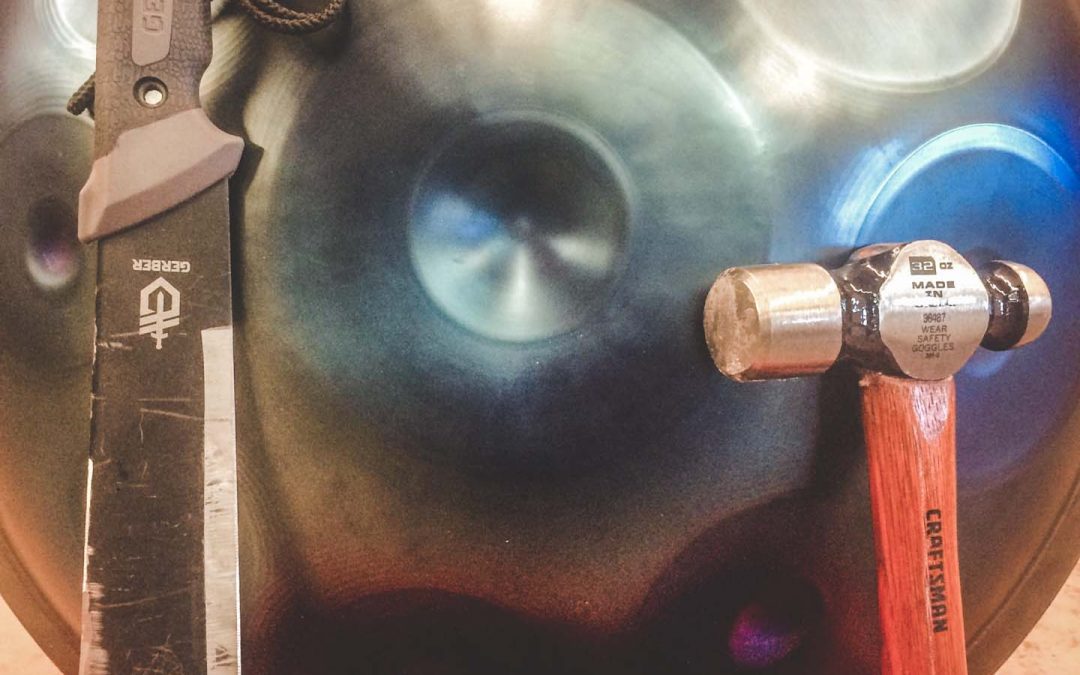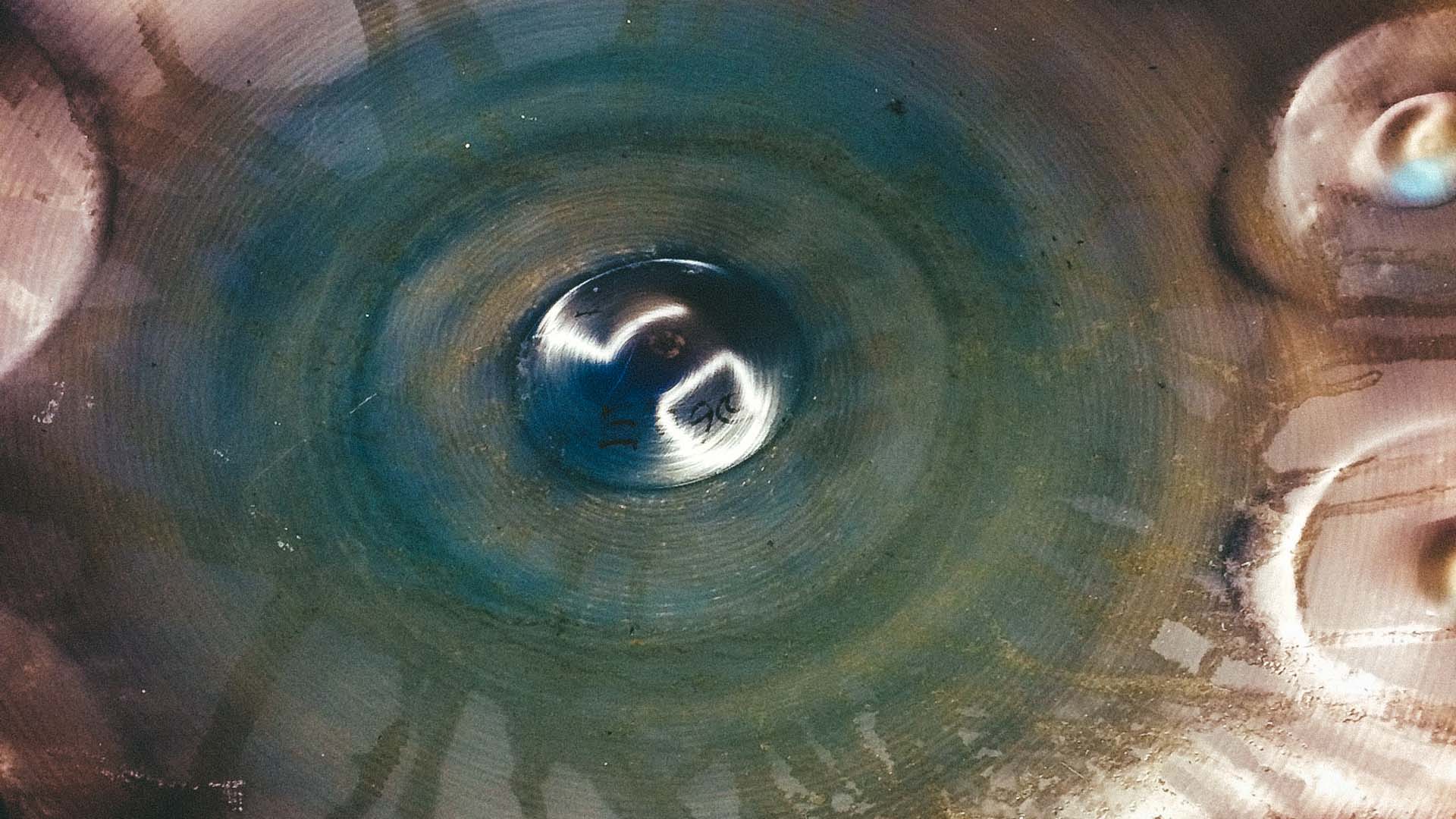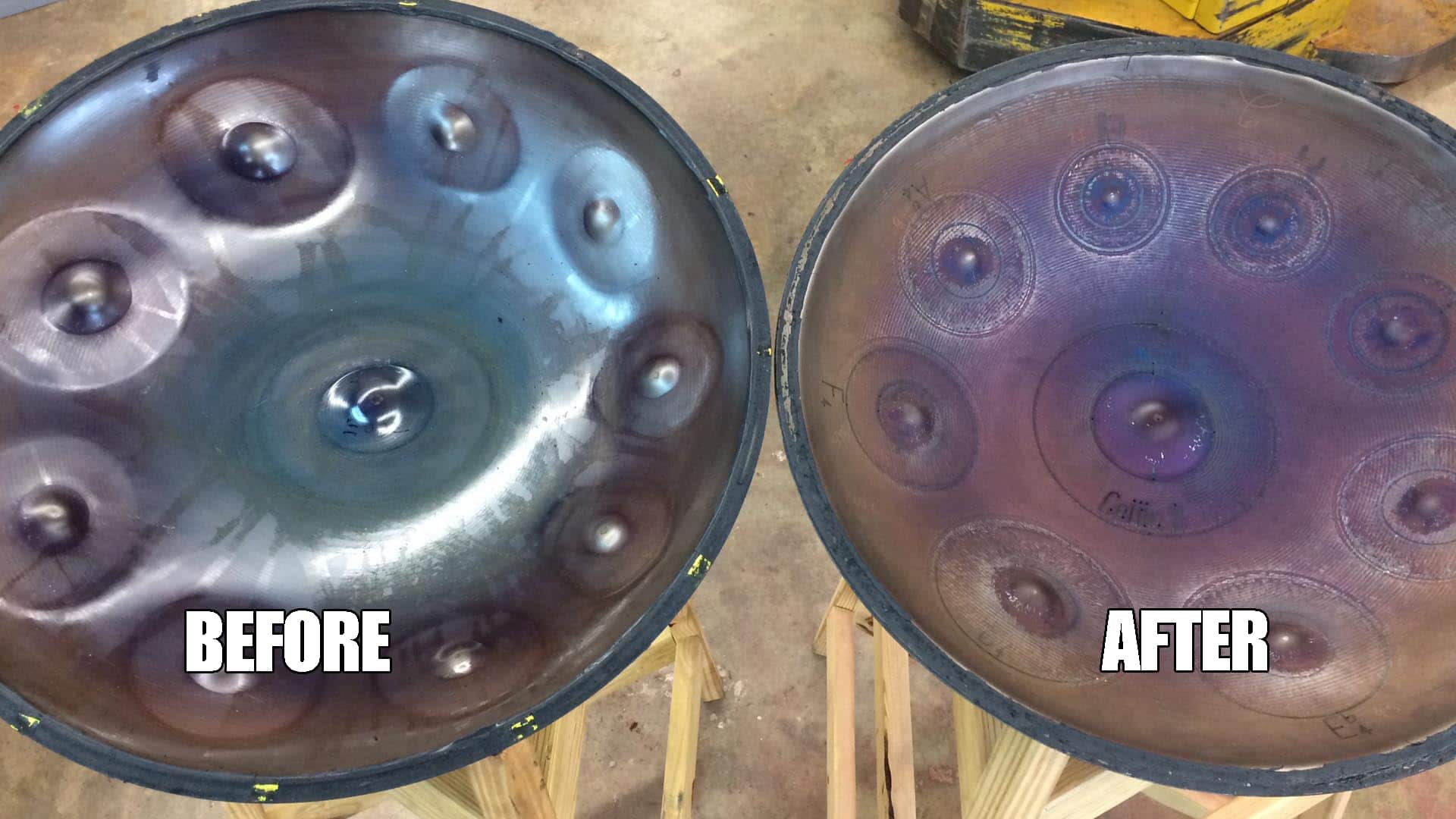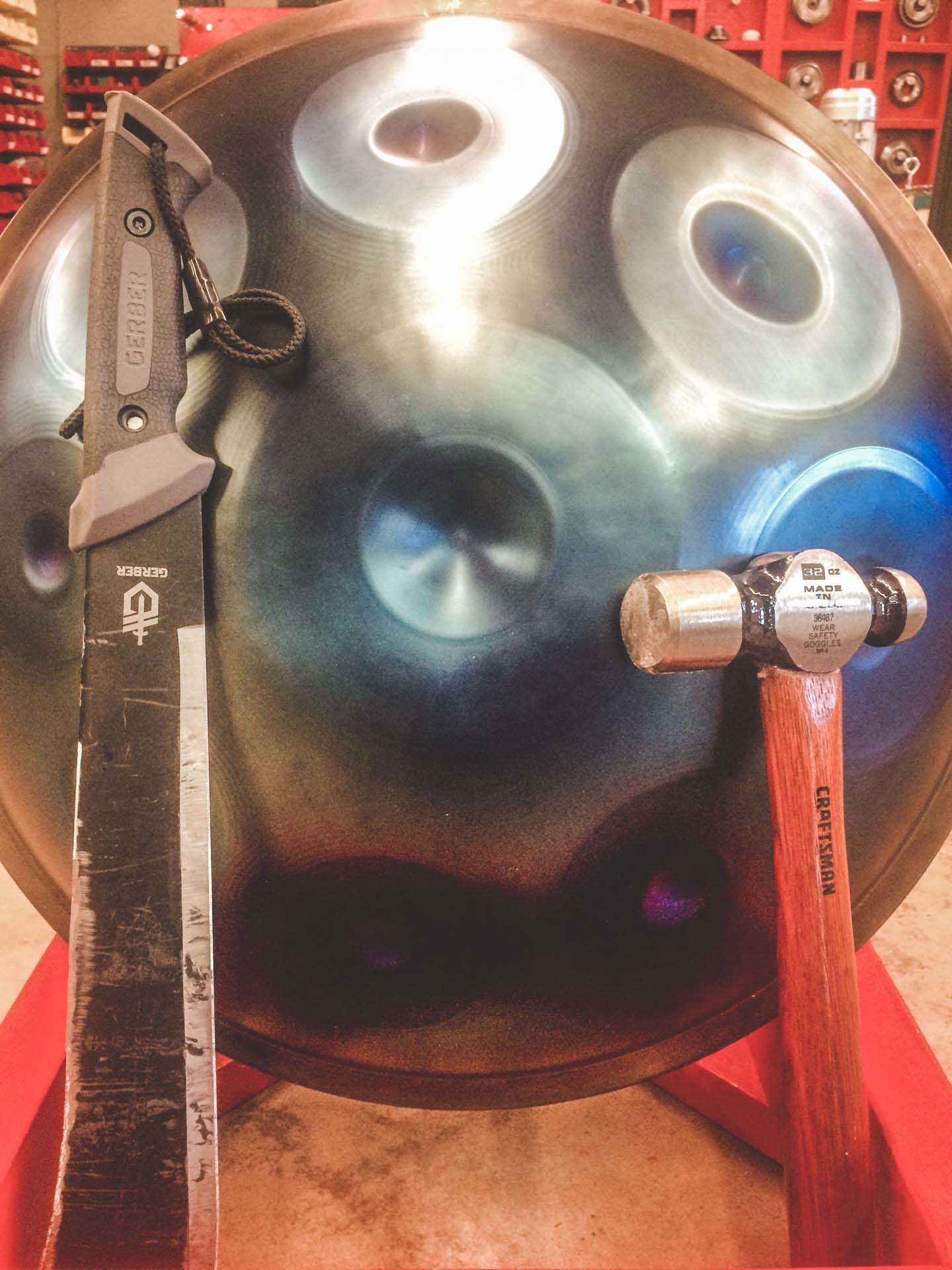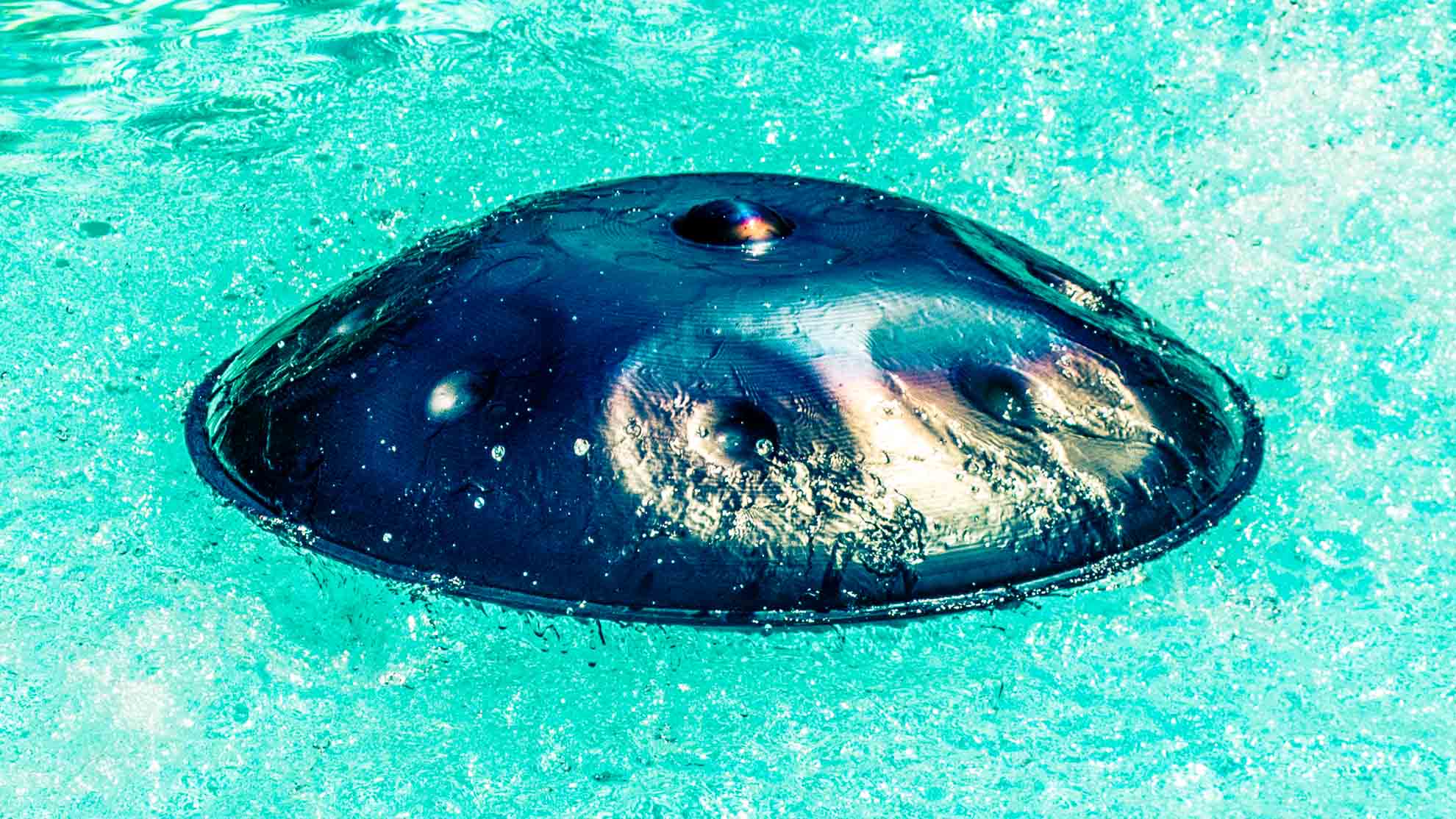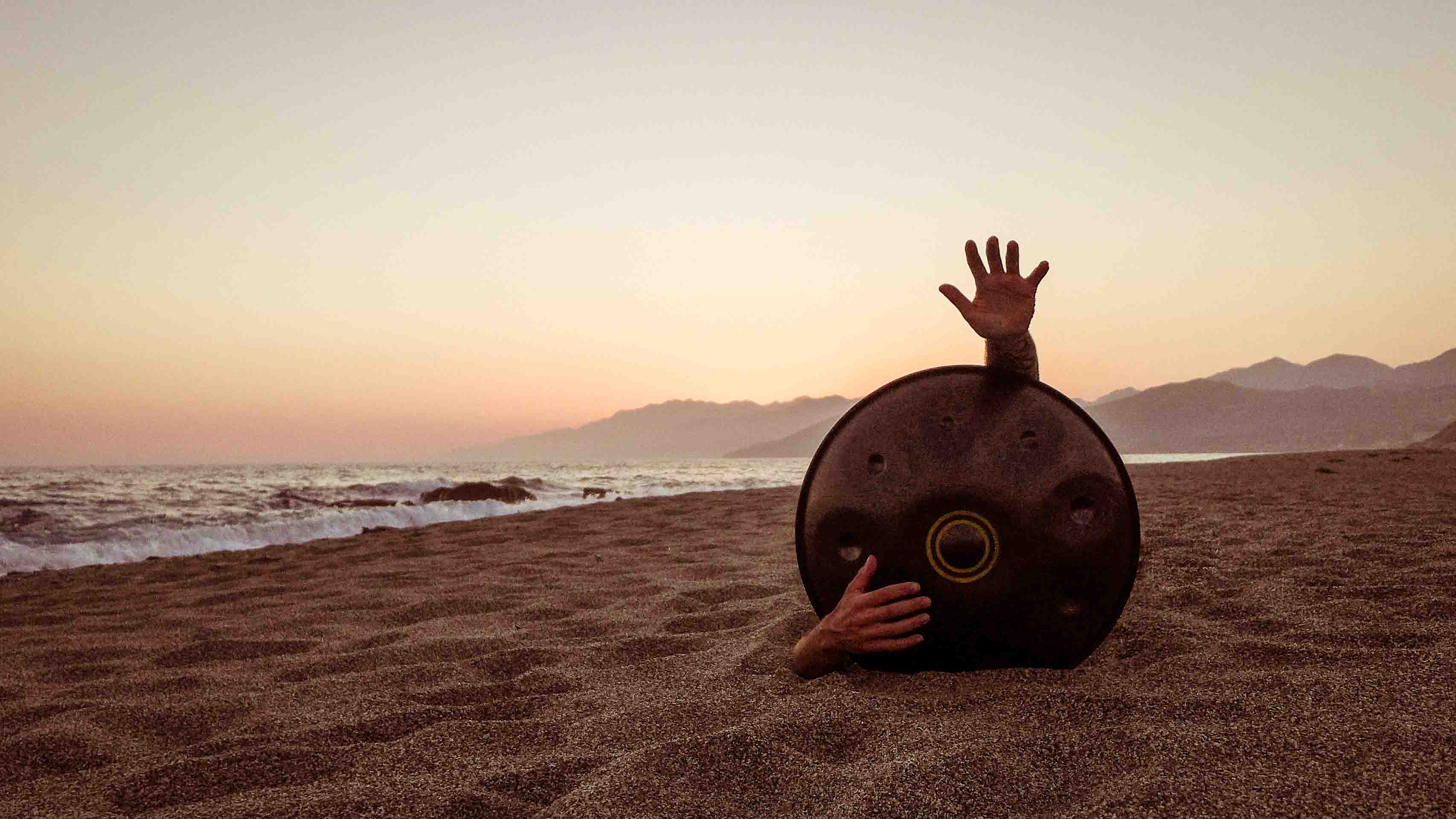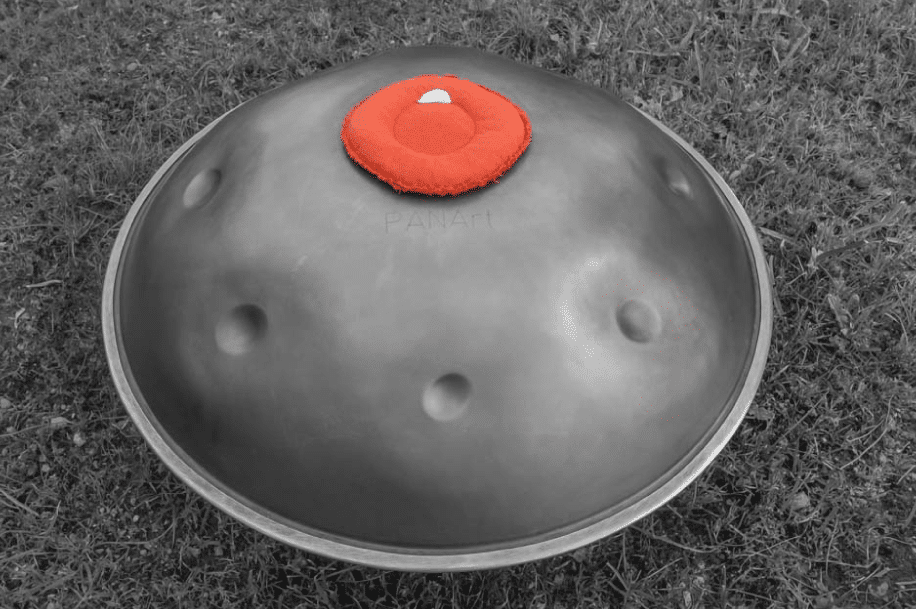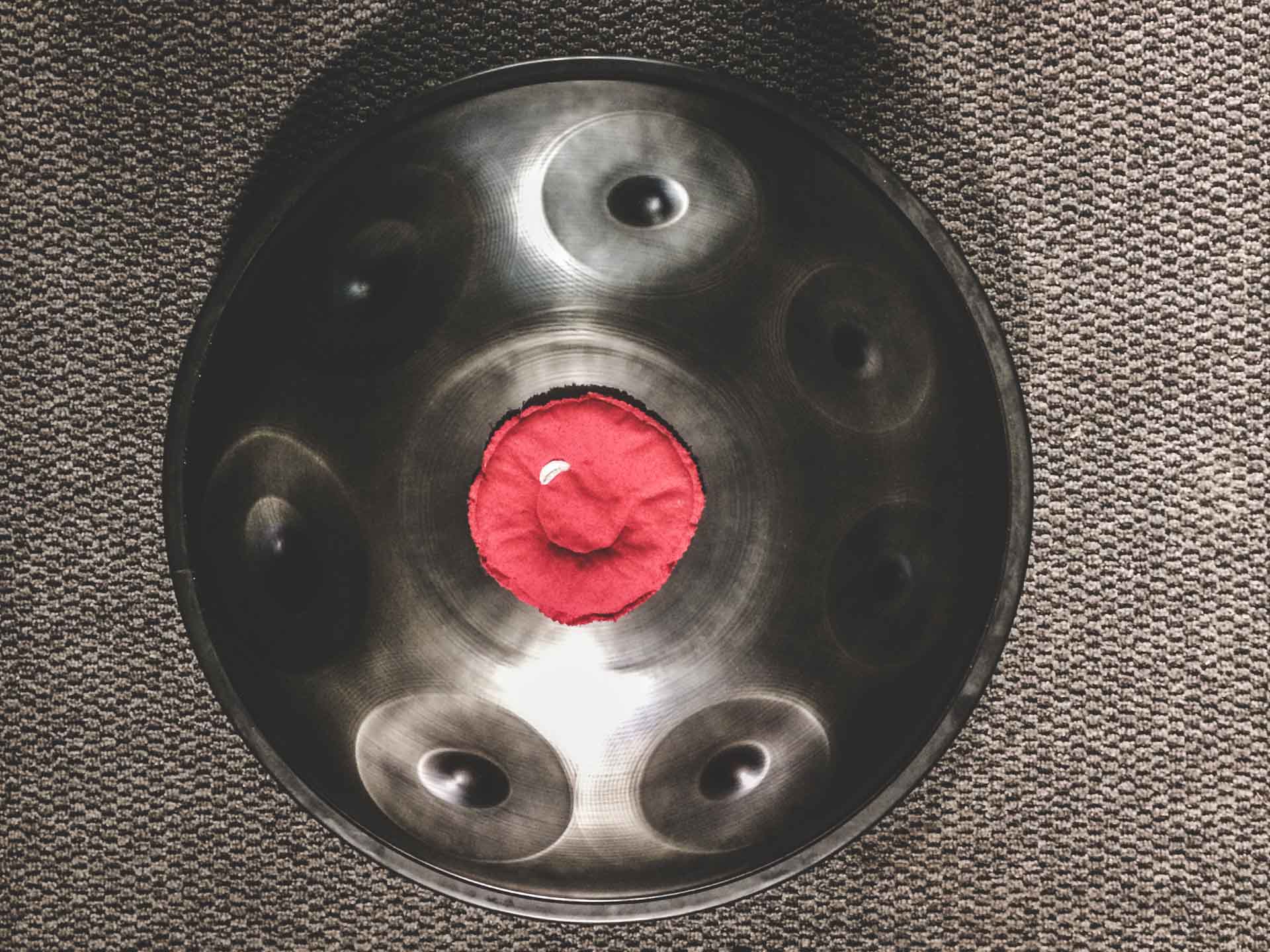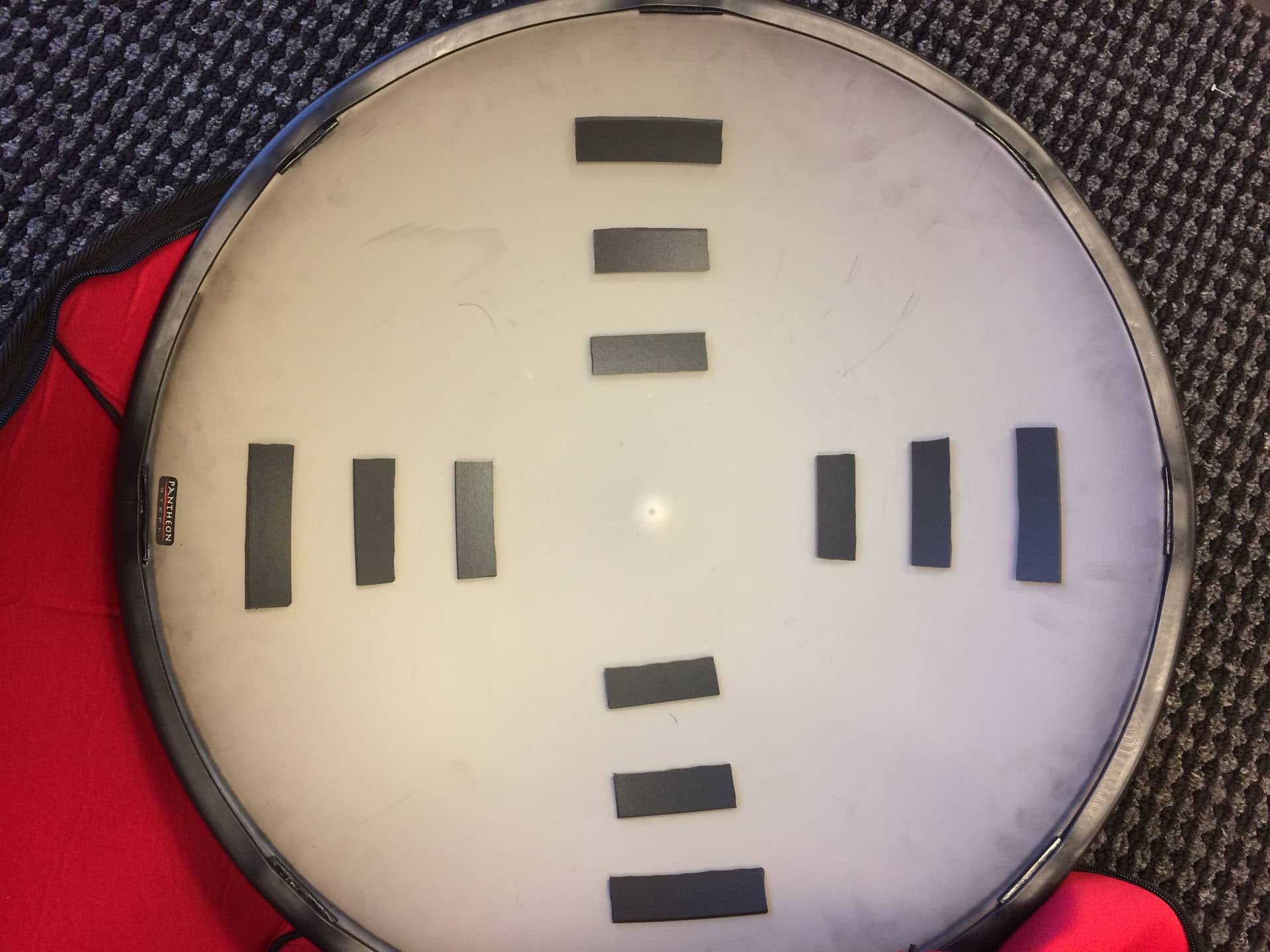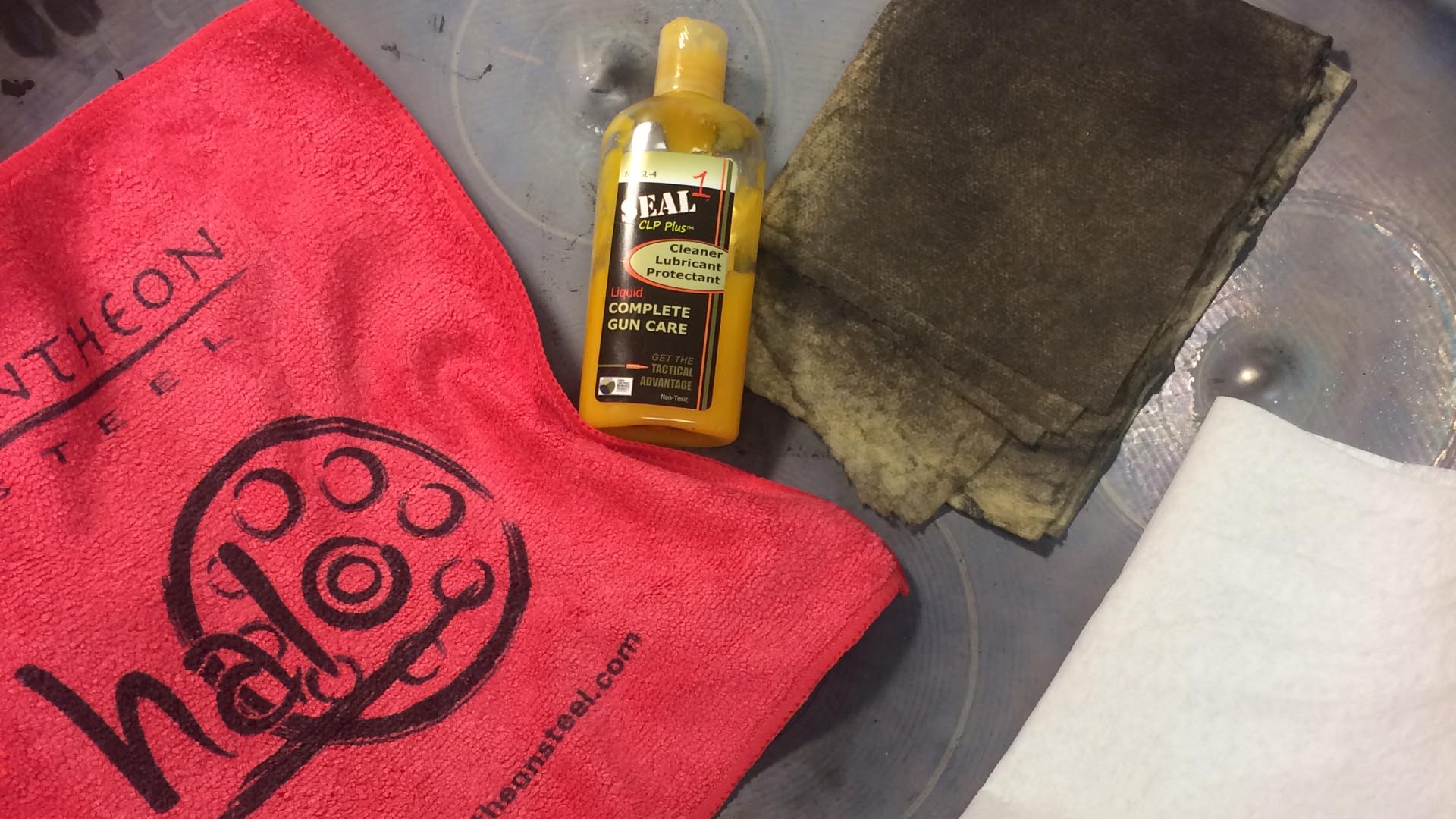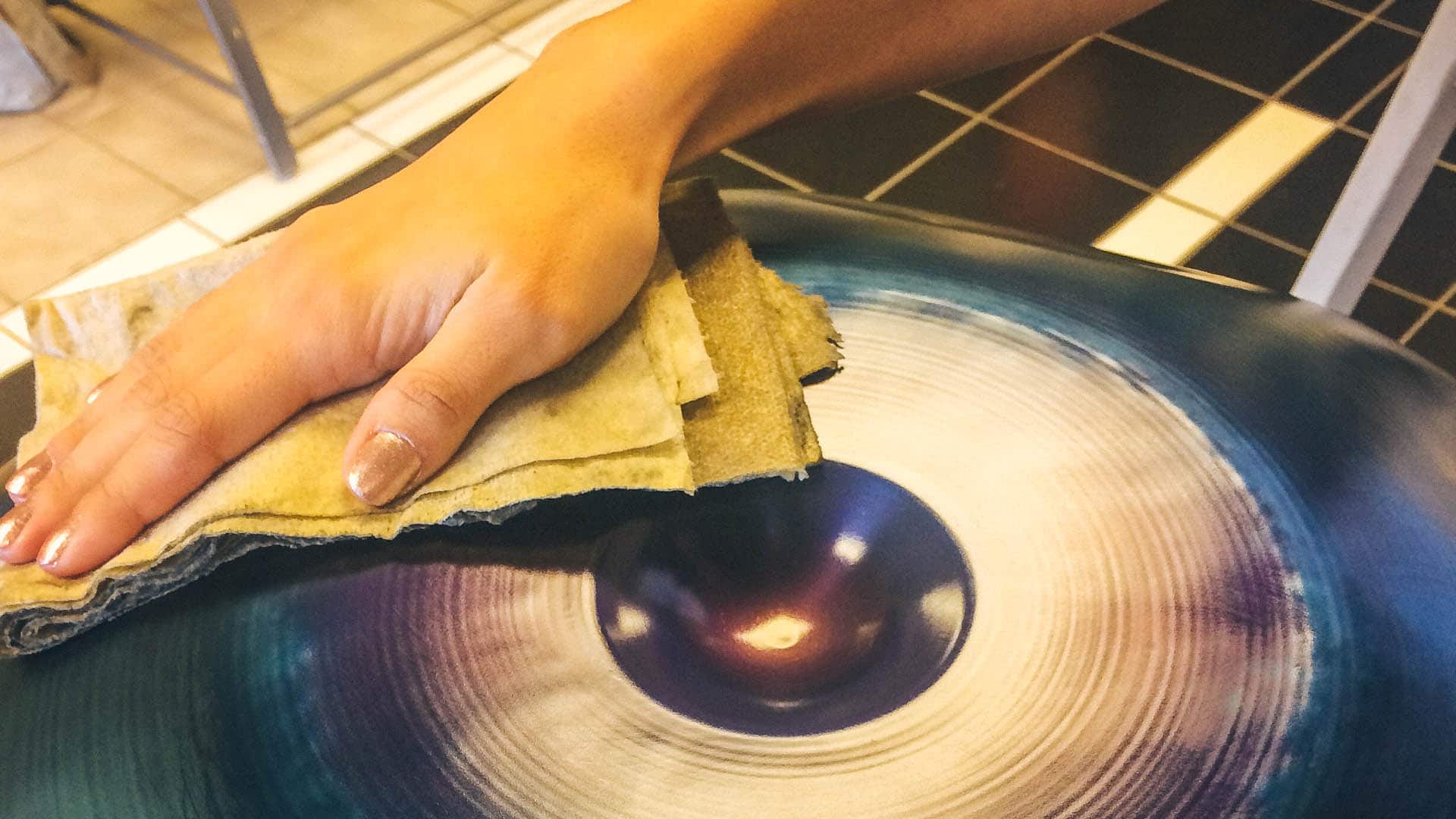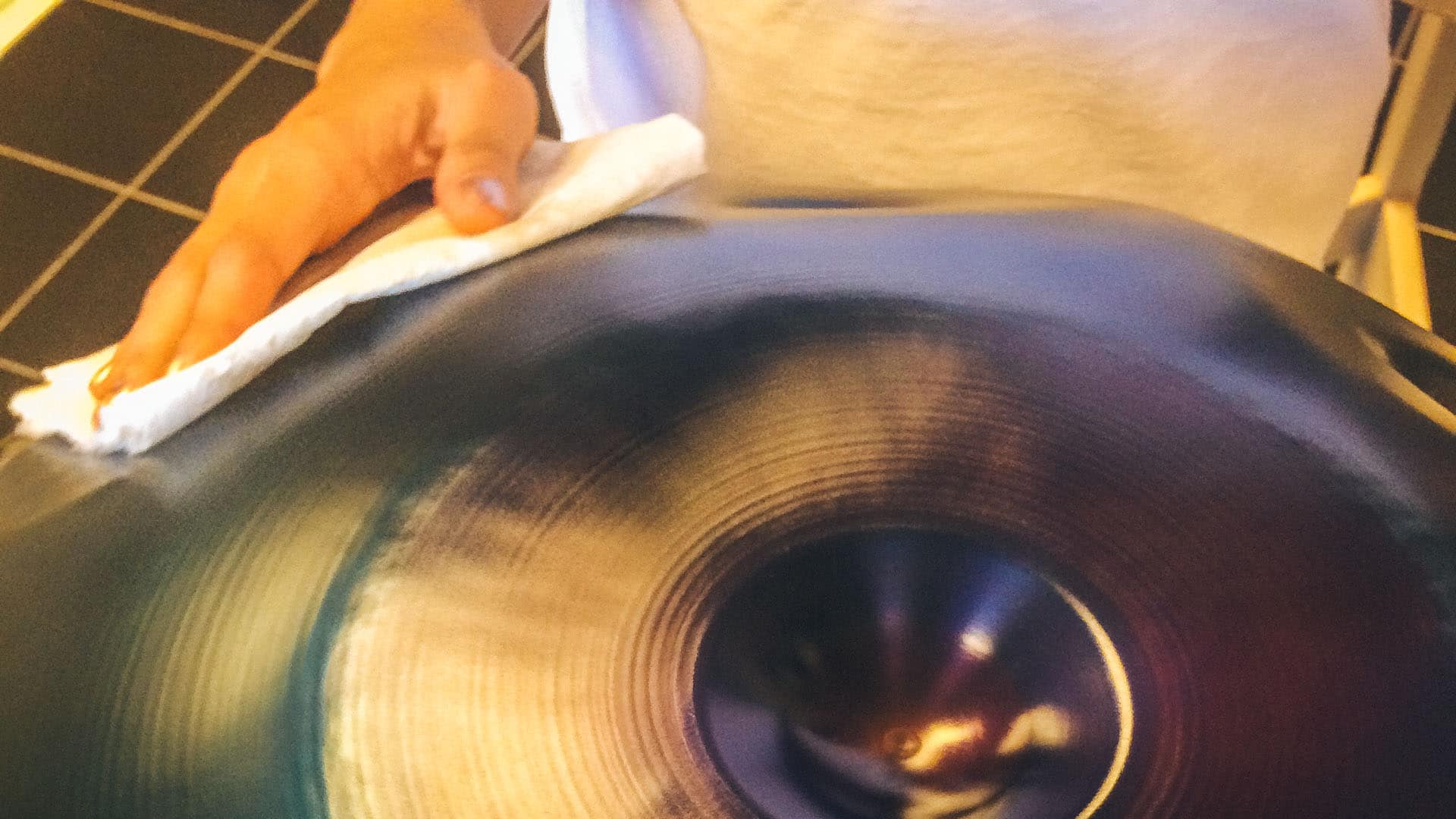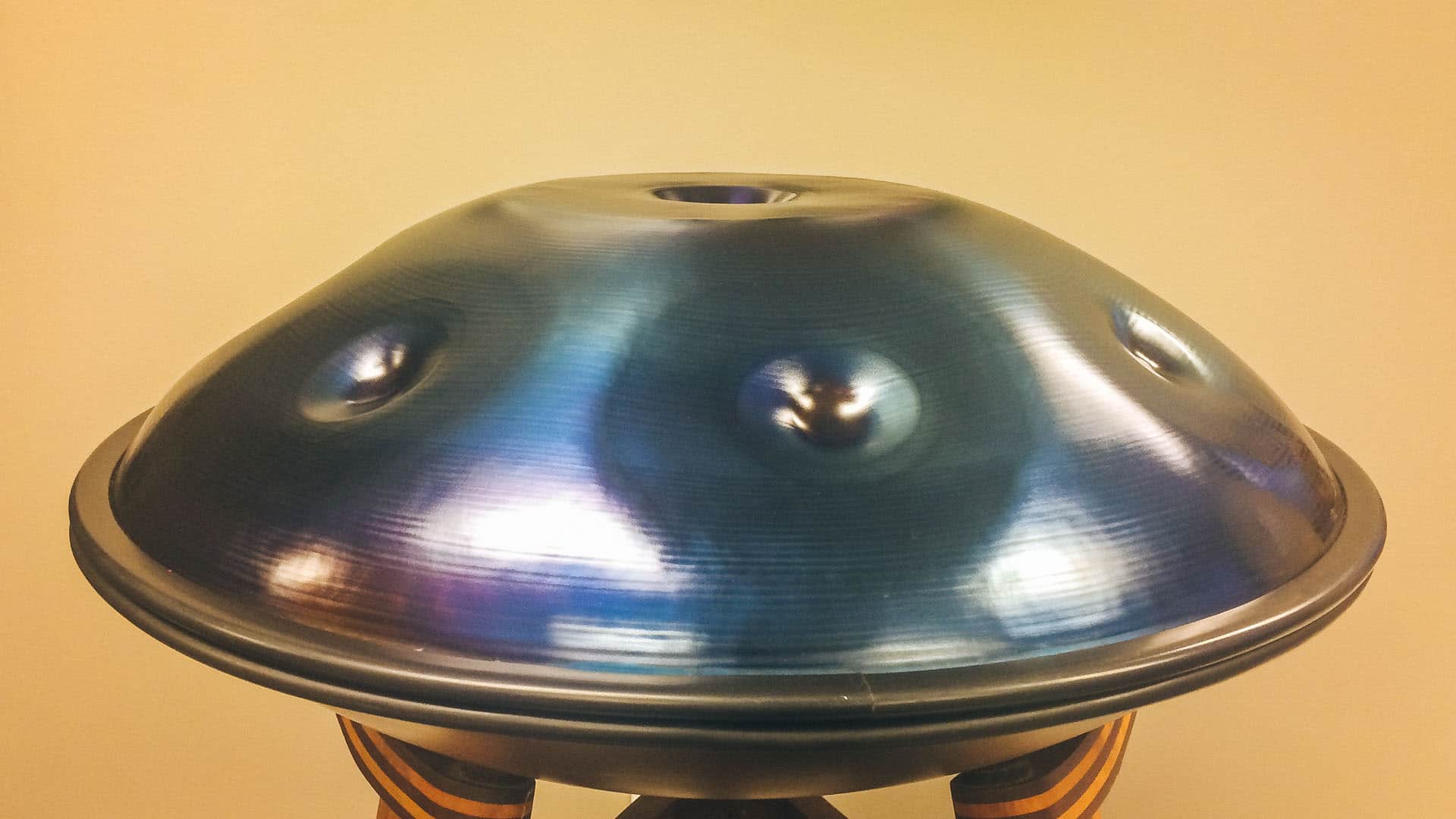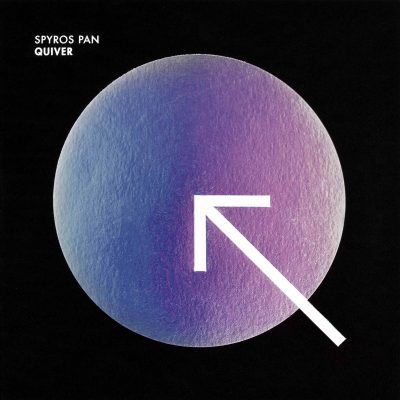Just like in most cases, “everything in moderation” a principle suggested by Cleobulus (Κλεόβουλος ο Λίνδιος) who walked on this earth around the 6th century B.C remains the best practice nearly three thousand years after. Applying treatments on the surface of handpans is no exception to that rule.
Three Halos were sent for a retune back to Pantheon HQ this week, their owners reporting lack of or no resonance. Indeed once we tried them, the Halos were dead or very poor in sustain, which is quite unusual for Halos. From a first hands on inspection on the shape of the instrument we could not see anything wrong. Two of these instruments were also very new which added up to being puzzled why this was the case.
And then we put our hand inside the vessel through the port only to find out that the surface INSIDE the instrument was full of Froglube. Here is how this looks.
Now, to see this once can be accidental. Twice OK, accidental again. But three times, then the statistician in me says: “ladies and gentlemen, we have a pattern”. One that is not good at all, actually. Therefore I believe we should really start from the basics because cleaning this mess entails splitting your instrument and that is something you do not for the fun of it.
Let there be sound!
In physics, sound is a vibration that propagates as a typically audible mechanical wave of pressure and displacement, through a medium such as air or water. The sound waves are generated by a sound source, such as the vibrating diaphragm of a stereo speaker.
Here is a definition:
Sound is defined as “(a) Oscillation in pressure, stress, particle displacement, particle velocity, etc., propagated in a medium with internal forces (e.g., elastic or viscous), or the superposition of such propagated oscillation. (b) Auditory sensation evoked by the oscillation described in (a).” Wave is the main source of sound. Man can only listen to sound in 20 Hz-20000 Hz. (source: https://en.wikipedia.org/wiki/Sound)
The important words we need to stay focused on here are: VIBRATION, WAVE and DIAPHRAGM.
The human visual system can theoretically process 1000 separate images per second but is not noticeable to the untrained eye after about 150 and up to around 240 where motion looks realistic. Modulated light (such as a computer display) for example is perceived as stable by the majority of participants in studies when the rate is higher than 50 Hz through 90 Hz.
Now when it comes to the string of a guitar, our eyes can perceive the vibration when we strum it. When it comes to the membrane of a tone field however, we cannot perceive the vibration with our bare eyes. And yet simply because we cannot see it, this doesn’t mean it’s not there! See where I am getting at? I know the majority of us knows this beforehand but still the picture of a handpan full of oil treatment residue on the inside makes me want to highlight the obvious:
If you wish your handpan sound to resonate, the steel needs to be able to vibrate.
To do that the membranes or tone fields need to be “open” and not muted for instance by a thick layer of froglube, seal1 or any other oil treatment. It is plain physics. Pure and simple.
I understand that carring for your handpan is very important to you, after all they are hard to come by and most probably the acquisition of one cost you pretty dear. It is a handmade instrument after all, no? Nevertheless, there is a limit to how far one can go and here again comes that ancient greek wisdom from the beginning of this fine post of a blog.
Everything in moderation.
If you take it to the extremes (such as applying froglube on the inside of your instrument) no wonder there are going to be consequences. In this specific case there is only one way for the handpan to be thoroughly cleaned. It needs to be cut open because the hand cannot move so freely in the bowels of the instrument…leaving your with only this unfortunate workaround and that’s when things can get a little bit tricky. Just take a look at the tools required for the job.
And this is how you use them:
So if the point was made crystal clear, lets depart then on a little tutorial that could be titled “how to care for your handpan”. Here are some general rules:
- never store it wet.
- never store it in a wet bag.
- never leave it exposed under the sun. The heat screws up the tension. if you happened to forget it under the sun, wait until it cools down before playing on it.
- it is not a DRUM. Remember? Try not to beat it just like this guy:
Ouch! That video always leaves me with an open mouth. That cowboy is really something.
Anyway, the last two points have to do with the tuning health of the instrument and a whole different post can be written about them. In this one we are going to focus on the first two. Let’s see what it all boils down to then.
(the) Environment Rules (us all)
“Rust will eat them“, is a famous quote by Victor Levinson and I cannot but agree with him. Given sufficient time, oxygen, and water, any iron mass will eventually convert entirely to rust and disintegrate. Rusting is the common term for corrosion of iron and its alloys, such as steel.
Your handpan is most probably nitrided of course, a process that not only hardens the metal it also provides an anti-rust coating. This does not mean your handpan is rust free. Nitriding slows down this process but if you are not careful and loving to your instrument it is going to rust so quickly you are not going to believe it. Although we cannot have control over time and oxygen, we can slow down corrosion by minimising the water element that our instruments are exposed to.
Normally, handpan owners should not really be afraid of allowing their instrument to get wet. After all it is not made out of sugar. It is metallic. Why should you prevent yourself from listening to your handpan being played by the rain?
Or try playing it on water.
… or … underwater :O
If you dry it carefully and thoroughly inside out then you should have no problem. Those pictures above where taken 6 years ago (doesn’t time fly) and the Halo is still rust free even after being in that swimming pool for more than 2 hours. And guess what. I have never, ever applied any froglube or other similar treatment on it. Not even once. The main reason to do is because this oily sensation of my fingers gives me a post playing feeling similar to eating french fries without a fork! And since my handpans are still looking good, I realised that maybe there is no need to after all.
Here is what I have been doing to keep them in top notch condition.
1. Clean your handpan EVERYTIME you finished playing it.
Exactly the same way you see all those stage musicians who really care for their instrument wipe it with a cloth before storing it. Steel is a porous material that sucks up everything on it. Fingers and hands are usually greesy from body oils, dirty and have the bad habbit of leaving dead cells behind them. The accumulation of all that grime remains on your handpan and that is no good. I always have a microfibre cloth inside the bag, which I use to wipe the surface clean after every playing session. Get into the habit and discipline of doing that. If you have one instrument it is easy. More than one can be tedious, I know. Nevertheless, isn’t it nice to play on a clean, shiny and smooth playing surface?
2. Playing in humid places (especially close to the sea).
Yes I know. Playing on a beach during the magic hour can be so inspiring. The sound of the waves, the warm summer breeze… oh yes (deep sigh) … The romance. Time for a reality check?
Salty humidity is treacherous and can have the same devastating effect with that of a cat’s paw on your velvet curtains. The condensation on a beach especially during sunrise and sunset are really high. And since you are next to the sea, you are exposing your handpan to salt, notoriously known for enhancing the corrosion.
So if you wouldn’t like your handpan to look like this then always, but always wipe your instrument clean after you are done with your playing and always, but always have the bag closed when you play so that it won’t get damp with salty humidity. Playing on a beach will also make you the center of attention. Unavoidably. It’s in the nature of the handpan. You might find yourself talking to people for a while during which time it could be that you will let your handpan on the sand only to attend to it say half an hour later. That is a no no, especially during dusk and dawn. If you wish to engage in friendly conversations, you are best advised to secure your instrument in its case before engaging.
3. Store it dry in a dry bag.
Remember that bag I mentioned above, the one that should always be kept dry? This is a tip that Felix gave me when I was leaving the Hangbauhaus with my 2nd gen on my back.
“Never store you handpan wet in a bag or dry in a wet bag or both” he said “or you will be greeted with a nasty surprise next time you take it out”.
I followed Felix’s instructions closely and ten years after my 2nd gen is still in pristine condition, so there is no picture to show you what can happen to your precious. Now, there might be situations where your bag is wet and you cannot do otherwise.Here is a little story:
I was at this festival in Japan and in the middle of the night it started pouring so heavy, for a moment I thought I could see fish swimming in the rain. Considering this was my shelter for the night (the weather was very good throughout the day),
I did not have to worry for my 2nd gen as it was kept tight inside the 2nd gen plastic case. The softbag surrounding my halo however, was soaking wet. To make things worse, anything dry was 4 hours drive away.
What I am trying to say here is that there might be cases where your handpan case/bag will get wet and there will be nothing you can do about it. That is not a problem as long as you aim to return to your base ASAP and remove the handpan out of the bag wipe it clean and let the bag dry well before you use it again. That is all there is to it and you should be fine. Having an instrument in a wet bag is a reason to be concerned but not something to take your stress levels into the red.
4. Use a Sounds Inspiring Moisture Eater.
Richard Bowring of Sounds-Inspiring based in the Netherlands makes very practical and reliable handpan accessories one of which is this little guy here:
The moisture eater does exactly what it’s name implies. It eats the moisture inside the bag ensuring of a drier environment for your handpan. This little gadget comes with a special indicator that turns pink when it has absorbed all the water it can, in which case you have to reset it by leaving it under direct sunlight for some time or on a radiator or by microwaving it. Once dry, the color on the label will turn blue and you can place it inside the bag again.
A word of caution here especially for Halo owners. If you use a halo helmet, placing the moisture eater in between those two might result in damaging your halo in case you drop it. Nothing should be placed between halo and helmet which would prevent the latter to uniformly cover the former. You are best advised to place it on the back side of your handpan as opposed to the image below:
should be avoided at all costs. If anything is placed in between your halo and helmet it came with, then all is happening is that the energy of a shock is not distributed evenly and guess where it is concentrated. Right on that extra padding that you yourself did put there to protect it. And then one wonders why… It seems that people do not think before doing stuff, but then again we find FrogLube inside a handpan, which was the driving factor for writing this article.
So coming back to the moisture eater. A wonderful gadget. I have one for all my handpans. Get yours directly from Richard here.
5. FrogLube and other relevant oil based treatments.
And finally we arrive to the staring point of this discussion. FrogLube. And french fries. If you really want to use it, I cannot prevent you. But you should learn how to use it well. This is how we do it at Pantheon before a new instrument leaves home.
Initially, we clean the halo thorougly from all kinds of dirt. Because the instrument came straight out of the workshop, we need to clean deep and for that purpose we use lacquer thinner. For domestic purposes however, such a strong chemical can be avoided unless you have left your handpan in the dirt for a prolonged period of time accumulating a lot of grime.
I use plain tap water at home. When I have time to spare, I take my instruments out on the balcony and sprinkle water on them simulating rain. I listen to their song for a little while and smile happily marveling at the wonders of life. Then I immediately dry them with a towel and finally I use a microfiber cloth to give them a nice clean finish. Once every six months I rub them with miracle cloth. I time this right before the beginning of summer when I usually work on islands for the season.
Miracle cloth is a wonderful rag with a great coconut odor. However, they are tricky and one has to be very careful when using them. Rub them more than you need, insisting on a spot and you will clear the coating which will ruin the looks of your awesome instrument. A gentle rub will do. Then use a microfiber cloth (not the one you usually clean your instrument with) to remove any residue and polish the surface.
Closing the miracle cloth parenthesis, lets return to the lube which I do not personally use but this goes out to all of you who want to so there you have it. Once you have cleaned the surface thoroughly it is time to apply the stuff. You will need:
- Seal1, FrogLube or equivalent
- a rag that you will dedicate for applying the stuff
- a perfectly clean cloth
- microfibre cloth (optional if you like your handpan less oily and shiny)
Choose a rag which you which will use only for the sole purpose of applying oil to your instrument. A few drops will do. No more. This rag eventually after many uses will get soaked in oil. You take that rag and tap it around the instrument. This will leave oil marks on the handpan. Once you have done this all around, use the same rag to evenly distribute the oil on the surface.
If you have applied the lube evenly all around the handpan it is time to grab the clean cloth – always use a clean cloth for this step – and start wiping it. You should end up with an extra shiny oily seal that covers all the playing surface uniformly.
If the seal breaks here and there you can reapply some by using the first rag and repeat with the second one until you reach a result such as this.
Your handpan is now sealed and ready to play. Still if I were to do this, I would leave it to rest for a day and marvel at the shine. Then I would wipe it again with the optional microfibre cloth to remove any extra residue and then I would start playing.
And there you have it. A comprehensive step by step guide how to keep the surface of your instrument rust free. Remember if you use any kind of oil treatment, just restrain yourself on the surface only and not on the inside of the instrument. Thank you very much!
Before leaving you I should not forget to mention that recently there have been some testing for new sealing alternatives. Alessio Massi from Hardcase Technologies as well as Josh Rivera from the Saraz team have been experimenting with potions. A new product called Phoenix Handpan Oil is now readily available made by Benny Bettane and his partner Alessia. As stated on various points in this post, I am not an advocate of oil treatment, so I am the worst person to suggest this brand over the other. I really do not like that shiny look when oil is applied to handpans. But that is just me writing here. Feel free to get in touch with the people mentioned above for they will have lots to tell you. One good thing about the Phoenix Handpan Oil is that the makers of the product come right from the handpan community, whereas Seal1 and FrogLube are established firms that predominantly cater for firearm enthusiasts. Plus their website claims Phoenix Oil does not interfere with sound. If I ever started sealing my instruments I would research them for sure!
Oh and since we are in this mode, here is a very comprehensive video by multi instrumentalist Jeremy Arndt showing you how to do care and clean your handpans. And please people…I know that I am repeating myself but after having split open three instruments in one day I have to insist and say it again. Leave the inside of your instrument oil free.
Be well and enjoy rust free handpans.

